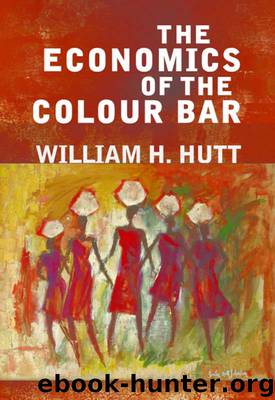The Economics of the Colour Bar by William H. Hutt

Author:William H. Hutt [William H. Hutt]
Language: eng
Format: epub
ISBN: 978-1-61016-062-9
Publisher: The Institute of Economic Affairs Limited
Published: 1964-11-06T16:00:00+00:00
1See Chapter 4, p. 32.
1It has been estimated that in the Cape Town area less than 30 per cent of employed Africans are illiterate, although about a quarter are literate in the Xhosa language only.
2This is probably the case with approximately half the Africans in urban areas other than mining areas.
1The growing population of the reserves, itself a response to enhanced urban earnings (in the mines and elsewhere), could not now subsist without contributions from African earnings outside.
2The possession of cattle confers prestige in the tribe. The traditional form of bride purchase is the transfer of cattle.
3It has been claimed recently that the per capita ownership of cars by Africans in the Republic is larger than that in Russia.
1Tribal Africans tend to be improvident in other senses; but as they become adjusted to urban life, they are capable of learning the meaning of thrift.
2African labour turnover is said to be much higher in these pursuits than in the mines. But Dr S. van der Horst has estimated that, in the Cape Town area, Africans over the age of 18 spend about 60 per cent of their working days in employment.
3The relative number of African women in urban areas seemed to have been increasing until the deliberate reversal of this trend during the last few years.
4Yet the original legislation which encouraged the perpetuation of this tradition aimed, at least ostensibly, at preventing social evils.
5Enquiries into recent riots brought out the fact that the rioters were wholly from single quarters. It has been reported that, at the Langa Location near Cape Town, 12,000 married Africans are living as bachelors in single quarters.
1The problems of migratory African labour in the gold mines are complicated by the fact that about two-thirds of the Africans employed are foreigners. (See below, pp. 92–3, 99–100, and Chapter 17, p. 155.)
2See, for example, Doxey, op. cit., p. 92.
3In recruiting Africans for mining work, their fares are frequently advanced. The usual contract is for periods of service of about nine months upwards, although the average is about 14 months. The Tomlinson Commission (1951) estimated that the migratory Africans are actually earning (i.e., actually doing paid work) during a period of only about 38 per cent of their working lives,
1 Doxey, op. cit., pp. 177–8.
2This fact gives considerable weight to the argument of the government that the migrant Africans of the Republic must equally be regarded as ‘temporary sojourners’ in the mining and urban areas.
1Official control on the entry of Africans into urban areas. See Chapter 15, PP. 130–1.
1I am not suggesting, of course, that Africans employed in the Rhodesian copper belt have been permitted – by the powerful white labour union – to acquire and exercise skills freely; although a trend in that direction now seems imminent.
2Provided, of course, that the necessary disciplinary structure and the market determination of wage-rates are not frustrated.
3There is no law to forbid the apprenticeship of Africans who have managed to acquire the necessary educational qualification. But any attempt to do so would almost certainly be quashed by the Registrar of Apprenticeship, responding to labour union pressure.
Download
This site does not store any files on its server. We only index and link to content provided by other sites. Please contact the content providers to delete copyright contents if any and email us, we'll remove relevant links or contents immediately.
The Brazilian Economy since the Great Financial Crisis of 20072008 by Philip Arestis Carolina Troncoso Baltar & Daniela Magalhães Prates(117642)
International Integration of the Brazilian Economy by Elias C. Grivoyannis(87509)
The Art of Coaching by Elena Aguilar(52866)
Flexible Working by Dale Gemma;(23238)
How to Stop Living Paycheck to Paycheck by Avery Breyer(19613)
The Acquirer's Multiple: How the Billionaire Contrarians of Deep Value Beat the Market by Tobias Carlisle(12206)
Thinking, Fast and Slow by Kahneman Daniel(12008)
The Radium Girls by Kate Moore(11888)
The Art of Thinking Clearly by Rolf Dobelli(10166)
Hit Refresh by Satya Nadella(9011)
The Compound Effect by Darren Hardy(8764)
Tools of Titans by Timothy Ferriss(8176)
Atomic Habits: Tiny Changes, Remarkable Results by James Clear(8145)
Turbulence by E. J. Noyes(7913)
A Court of Wings and Ruin by Sarah J. Maas(7594)
Change Your Questions, Change Your Life by Marilee Adams(7592)
Nudge - Improving Decisions about Health, Wealth, and Happiness by Thaler Sunstein(7507)
How to Be a Bawse: A Guide to Conquering Life by Lilly Singh(7359)
Win Bigly by Scott Adams(7060)
